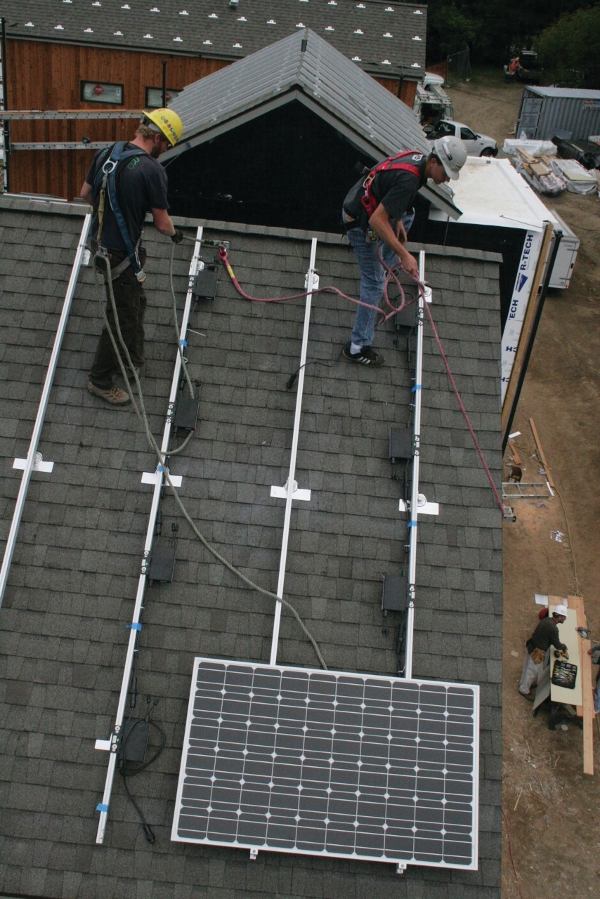APS America changes the game with microinverters that power multiple PV modules.
The microinverter market is turning into a pretty competitive place. Enphase is a dominating force, and multi-megawatt inverter manufactures — like SMA America and Power-One (now doing business as ABB) — have recently launched their own mini converters. And now the No. 2 global microinverter supplier (as ranked by GTM Research) is starting to focus its attention on North America. APS America, the latest division of Altenergy Power Systems (APS), which focuses much of its attention on China and Australia, has big plans for expansion in the coming years, including introducing the first three-phase microinverter that works with four modules.
 “We see ourselves as an innovator in this industry,” says APS America CEO Kelly Samson. “Over half of our employees are in research and development. This is an industry where you move or you perish. You have to keep innovating.”
“We see ourselves as an innovator in this industry,” says APS America CEO Kelly Samson. “Over half of our employees are in research and development. This is an industry where you move or you perish. You have to keep innovating.”
SURPASSING EXPECTATIONS
Zhi-Min Ling and Yuhao Luo founded APS in Silicon Valley in 2009. They were involved in PV panel manufacturing and producing programmable chips at Solaria and Xilinx. The two took their knowledge and started supplying microinverters to China and Australia, and APS was soon the largest supplier in both countries. APS America opened in Poulsbo, Wash., near Seattle, and has seen success on projects in Washington and Hawaii and recently announced distribution partnerships in Florida and Nevada.
“The heart of what we do is a field programmable gate array (FPGA), which gives us a ton of flexibility,” Samson says. “There are a lot of components in our world, but the FPGA is the brains. It gives us the ability to program very easily. Every year, panels are different. Every year ,there’s a difference in efficiencies. We can program [our inverters] and meet that demand.”
The APS flagship product is the YC500A, a dual-module microinverter.
“Our position is that we’re able to do a dual microinverter at an attractive price point due to the competitive advantages our topology has,” Samson says. “We have a different architecture than others. Others have tried… [but] it was not a successful ride for them.”
Microinverters typically work with one panel. As companies have begun experimenting with dual-panel microinverters, things get a little complicated. Instead of one new unit, some microinverter manufacturers were essentially taking two individual microinverters and combining it into one box. It was twice the size of a single microinverter. (United Kingdom-headquartered Enecsys’s dual-panel microinverter is one exception.)
“Our big leap forward was to be able to do a dual that is not twice as big as the single,” Samson says. “There’s a lot of dual use of parts inside that box. The box is 60 percent bigger than a single. That does a lot of magic things for you — makes the box smaller and lighter, makes it more efficient, less costly to manufacture, cheaper to ship and we have a significant price advantage over the competition.”
APS’s new ground-breaking product is the YC1000, the first three-phase microinverter that works with four modules. It’s moving along in beta testing and is currently deployed in China, including at a 230-kW commercial roof project near Shanghai. Its 780 modules only needed 195 YC1000 microinverters to power successfully, significantly cutting down on costs.
 REAL-TIME TESTING
REAL-TIME TESTING
APS microinverters were recently chosen for a project that is now Washington’s largest solar community. Grow Community, a new housing development on Bainbridge Island, built its homes to be net zero (or consuming no energy). The houses come with the ability to produce their own power and were designed to support PV panels on its roofs.
“Grow Community decided to make all the houses solar panel-ready and let the folks decide when they move in if they wanted that or not,” Samson says. “All [of the first phase of homes] have gone solar. They had three model houses built, and they sold the entire first phase without a realtor. It’s an attractive community.”
Samson says it’s been a great way for APS to prove its microinverters are dependable products.
“It’s been great for us as a business,” he says. “You’re monitoring your inverter in real time. When you have individual houses with the same brand of microinverter on the roof, it’s interesting to see if they’ll cross-talk or not. What keeps you from picking up the information from the panels next door? It’s all the same grid. We wanted to see if that would work, and sure enough it worked just fine. It’s been really good to have that life-sized incubator 10 miles from our factory.”
Samson says as things even out with module efficiencies, inverters will become a bigger player in the solar market.
“We feel like we’re in an industry that’s going to do very well in the next few years,” he says. “Modules are becoming more generic. They’re being more commoditized. The price point and the quality point between the top module manufacturers is a very narrow band — 2 to 3 cents per watt at most. They’re all fairly consistent in quality and price. All of a sudden, if you have a microinverter that saves 8 cents per watt, that’s a big number. It’s interesting to see how that’s going to unfold.
“We are ready to go to the dance.”
[source: http://solarbuildermag.com/featured/aps-america-microinverters/]

Leave a Reply
You must be logged in to post a comment.